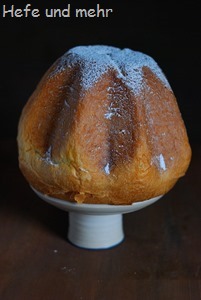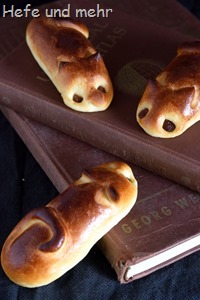 A reader told me about “Schulmäusen” (School mice), a small sweet roll filled with hazelnut praline. She tried to bake similar rolls in a spelt variant but struggled with them getting to dry. My brain worked a while on this idea in the background and came up with a recipe at the end – just in time for school start. As the name “Schulmaus” is a brand name, I decided to call my rolls Spelt mice and formed most of them like a mouse, too. But if you do not roll one end into a long tail, then you get the original form, too.
A reader told me about “Schulmäusen” (School mice), a small sweet roll filled with hazelnut praline. She tried to bake similar rolls in a spelt variant but struggled with them getting to dry. My brain worked a while on this idea in the background and came up with a recipe at the end – just in time for school start. As the name “Schulmaus” is a brand name, I decided to call my rolls Spelt mice and formed most of them like a mouse, too. But if you do not roll one end into a long tail, then you get the original form, too.
They are not a healthy snack, but a treat for small and big ones with a sweet tooth. The crumb is fluffy and the filling creamy – a good way to make school start a bit sweeter!

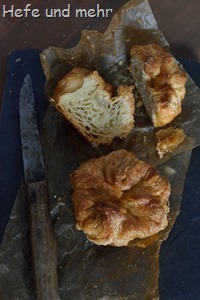 Butter is a staple in the Breton kitchen – which shows in the
Butter is a staple in the Breton kitchen – which shows in the 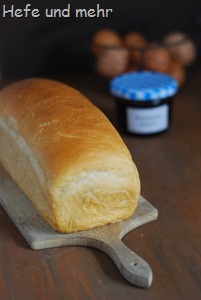
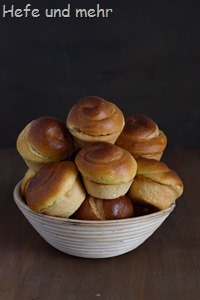 I met Honigreingerl some time ago and they trigger my “Have to bake” reflex of immediately. They are small Austrian pastries which are filled with a honey and cinnamon mixture. In their crumb you can find many small openings filled with the flavour of honey and cinnamon.
I met Honigreingerl some time ago and they trigger my “Have to bake” reflex of immediately. They are small Austrian pastries which are filled with a honey and cinnamon mixture. In their crumb you can find many small openings filled with the flavour of honey and cinnamon.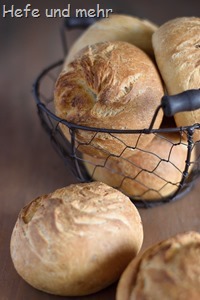 The
The 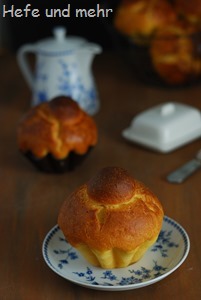 Here is –as I promised – the first spelt recipe (of hopefully many more). It is a variation of my brioche recipe, but with more egg yolk and a little water roux to increase the amount of liquid in the dough. A
Here is –as I promised – the first spelt recipe (of hopefully many more). It is a variation of my brioche recipe, but with more egg yolk and a little water roux to increase the amount of liquid in the dough. A 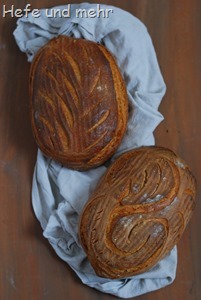 Sometimes, the best bread happens rather unplanned. Like this bread, which is a kind of a left over bread. It started when I was thinking about what to do with the remaining part of the “aromastück” I prepared when baking the “Irländer”. In the fridge was a big batch of
Sometimes, the best bread happens rather unplanned. Like this bread, which is a kind of a left over bread. It started when I was thinking about what to do with the remaining part of the “aromastück” I prepared when baking the “Irländer”. In the fridge was a big batch of 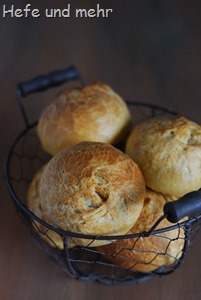 Kieler Semmeln are rolls which stem – as their name suggested – from Kiel. They are a special roll as they are rubbed in a mixture of butter and salt, which gives their surface a rough look and adds a nice buttery and sligthly salty flavour. There are different recipes around for this kind of rolls, some of the containing lard or cinnamon as well. Cinnamon seems to me a bit to adventurous for a first trial, but I keep this variant in the back of my head for a second version.
Kieler Semmeln are rolls which stem – as their name suggested – from Kiel. They are a special roll as they are rubbed in a mixture of butter and salt, which gives their surface a rough look and adds a nice buttery and sligthly salty flavour. There are different recipes around for this kind of rolls, some of the containing lard or cinnamon as well. Cinnamon seems to me a bit to adventurous for a first trial, but I keep this variant in the back of my head for a second version.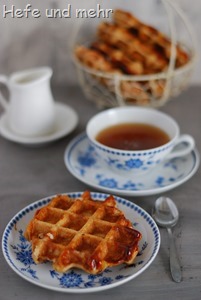 Tired, but happy I look back on the last week. Tired because I came back very late Sunday night just to leave again on early monday to morning to a mass spectrometry training in Frankfurt. Luckily there was not as much snow as forecasted and all trains were in time. Thinking on the bread festival in Berlin makes me still smiling, as it was such a good experience. I’m very happy that I met some of my Readers there!
Tired, but happy I look back on the last week. Tired because I came back very late Sunday night just to leave again on early monday to morning to a mass spectrometry training in Frankfurt. Luckily there was not as much snow as forecasted and all trains were in time. Thinking on the bread festival in Berlin makes me still smiling, as it was such a good experience. I’m very happy that I met some of my Readers there!